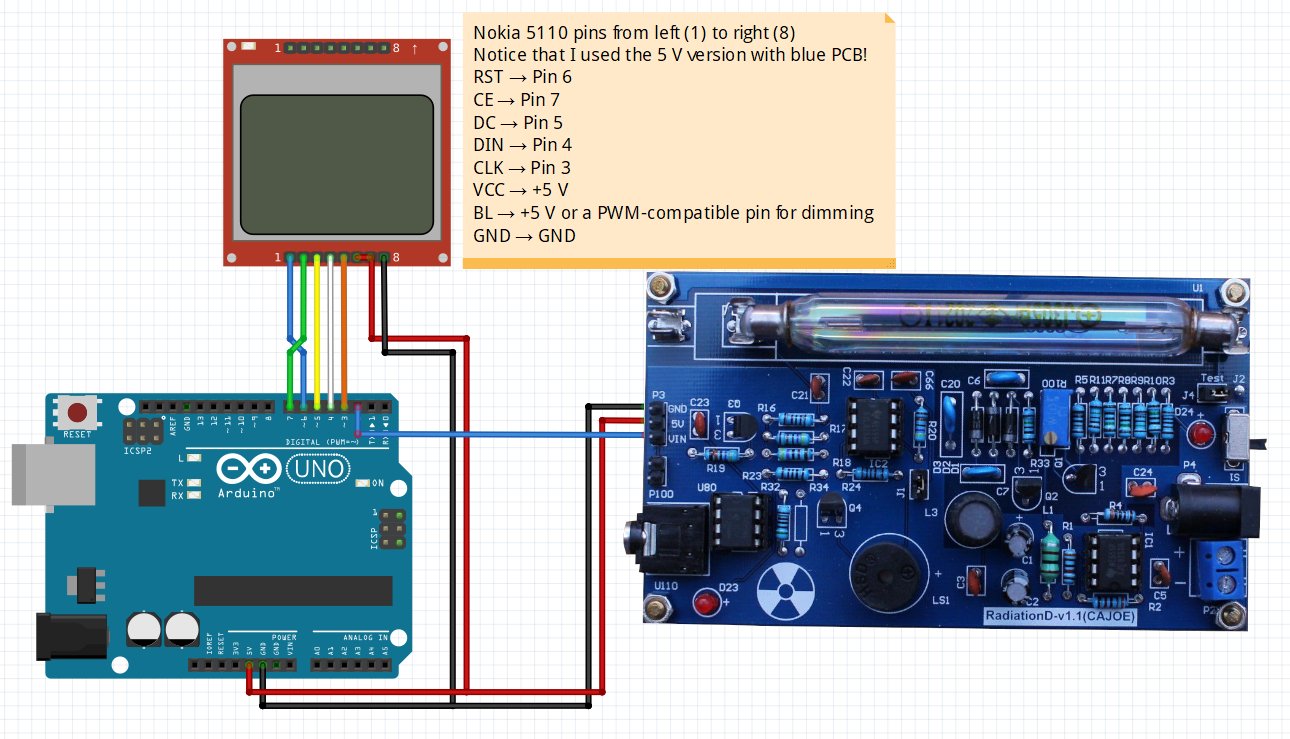Geiger-Müller counter demonstration
A very simple circuit with an Arduino Uno, a Nokia 5110 LCD and a Geiger-Müller counter board. It is so simple that one only has to wire everything and upload the code and it works!
Schematics
Pin connections for Arduino Uno as demonstrated in the video. The Geiger-Müller board is powered by the Arduino by the +5 V and GND connections. The VIN pin of the board goes to pin 2 on the Arduino which is an interrupt pin. This pin captures and registers the “clicks” generated by the board when an ionizing particle is detected.
Arduino source code
#include <PCD8544.h> #include <SPI.h> #define integratingTime 15000 //Logging period in milliseconds #define oneMinute 60000 //One minute unsigned long counts = 0; //variable for GM Tube events unsigned long events = 0; unsigned long cpm = 0; //variable for CPM unsigned int multiplier; //variable for calculation CPM in this sketch unsigned long previousMillis; //variable for time measurement double avgCounts = 0; double avgCPM = 0; double avgUSV = 0; double sumCPM = 0; double sumUSV = 0; double uSv = 0; double dose = 0; const int ledPin = 9; static PCD8544 lcd; void tube_impulse() //subprocedure for capturing events from GM board { counts++; events++; } void setup() { // PCD8544-compatible displays may have a different resolution... lcd.begin(84, 48); counts = 0; cpm = 0; multiplier = oneMinute / integratingTime; //calculating multiplier, depend on your log period Serial.begin(9600); attachInterrupt(digitalPinToInterrupt(2), tube_impulse, FALLING); //define external interrupts pinMode(ledPin, OUTPUT); Serial.println("GM Tube - Send 's' to start..."); } void loop() { withserialPort(); } void withserialPort() { if (Serial.available() > 0) { lcd.setCursor(0, 4); //row 5 lcd.print("Counts: "); lcd.print(events); char cin = Serial.read(); if(cin = 's'){ while(Serial.read() != 'N') { lcd.setCursor(0, 4); //row 5 lcd.print("Counts: "); lcd.print(events); unsigned long currentMillis = millis(); if(currentMillis - previousMillis > integratingTime){ avgCounts++; previousMillis = currentMillis; cpm = counts * multiplier; //cpm * 60/15 = cpm * 4 uSv =( cpm / 151.0); sumCPM = (double)cpm + sumCPM; sumUSV = uSv + sumUSV; avgCPM = sumCPM / avgCounts; avgUSV = sumUSV / avgCounts; //print cpm on serial Serial.print((currentMillis)/1000); Serial.print("\t"); Serial.print(cpm); Serial.print("\t"); Serial.print(avgCPM); Serial.print("\n"); //print on LCD lcd.setCursor(0, 0); //row 1 lcd.print("S CPM uSv/hr"); //first row: information lcd.setCursor(0, 1); //row 2 lcd.print("N "); lcd.print(cpm); lcd.print(" "); lcd.print(uSv,4); lcd.setCursor(0, 2); //row 3 lcd.print("A "); lcd.print(avgCPM,1); lcd.print(" "); lcd.print(avgUSV,4); counts = 0; //------------------------------------- } } } } }
